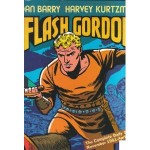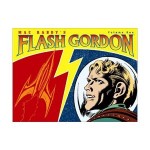
By Dan Barry & Harvey Kurtzman, with Frank Frazetta (Kitchen Sink Press)
ISBN: 978-0-86801-969-7
By most lights Flash Gordon is the most influential comic strip in the world. When the hero debuted on Sunday January 7th 1934 (with the superb Jungle Jim running as a supplementary “topper†strip) as an answer to the revolutionary, inspirational, but rather clunky Buck Rogers strip of Philip Nolan and Dick Calkins (which also began on January 7th, but five years earlier) two new elements were added to the wonderment; Classical Lyricism and astonishing beauty.
Where Rogers blended traditional adventure and high science concepts, Flash Gordon reinterpreted Fairy Tales, Heroic Epics and Mythology, spectacularly draping them in the trappings of the contemporary future, with varying ‘Rays’, ‘Engines’ and ‘Motors’ substituting for spells, swords and steeds – although there were also plenty of those – and exotic craft and contraptions standing in for Galleons, Chariots and Magic Carpets.
Most important of all, the sheer artistic talent of Raymond, his compositional skills, fine line-work, eye for sumptuous detail and just plain genius for drawing beautiful people and things, swiftly made this the strip that all young artists swiped from.
When all-original comicbooks began a few years later, dozens of talented kids weaned on the strip’s clean-lined, athletic Romanticism entered the field, their interpretations of Raymond’s mastery a ticket to future success in the field of adventure strips. Almost as many went with Milton Caniff’s expressionistic masterpiece Terry and the Pirates (and to see one of his better disciples check out Beyond Mars, illustrated by the wonderful Lee Elias).
For over a decade sheer escapist magic in a Ruritanian Neverland, blending Camelot, Oz and every fabled paradise that promised paradise yet concealed hidden vipers, ogres and demons, enthralled the entire world, all cloaked in a glimmering sheen of sleek art deco futurism. Worthy adversaries such as utterly evil, animally magnetic Ming, emperor of a fantastic wandering planet; myriad exotic races and fabulous conflicts offered a fantastic alternative to the drab and dangerous real world…
Alex Raymond’s ‘On the Planet Mongo’, with Don Moore doing the bulk of the scripting, ran every Sunday until 1944, when the artist joined the Marines. On his return he would create the gentleman detective serial Rip Kirby. The one continuous, unmissable weekly appointment with sheer wonderment, continued under the artistic auspices of Raymond’s assistant Austin Briggs who had drawn the daily instalments since 1940.
That Monday to Saturday black and white feature ran from 1940-1944 when it was cancelled to allow Briggs to take over the Sunday page. Often regarded as the poor relation, the daily strip got an impressive reboot in 1951 when King Features, keenly aware of the science fiction zeitgeist of the post-war world, revived it, asking Dan Barry to produce the package. The Sunday was continued by Austin Briggs until 1948 when Mac Raboy assumed artistic control, beginning a twenty year resurgence of classical brilliance. On Raboy’s death Barry added the Sunday to his workload until he quit over a pay dispute in 1990.
Barry (1911-1997) started as a jobbing artist in comicbooks, a contemporary of Leonard Starr and Stan Drake. Like them and his brother Seymour “Sy†Barry (who produced The Phantom newspaper strip for three decades) Dan worked in a finely detailed, broadly realistic style, blending esthetic sensibility with sharp detail and strong, almost burly virile toughness – a gritty “He-man†attitude for a new era and defined as “New York Slickâ€.
Dan Barry drew such varied comicbook series as Airboy, Skywolf, Boy King, Black Owl, Spy Smasher and Doc Savage before joining the Air Force. Returning after the hostilities he drew The Heap and assorted genre shorts for new titles such as Crimebusters. He also started his own business producing educational and informational comics.
He began the gradual departure from funny-books as early as 1947 when he took over the Tarzan daily strip for a year but he was still gracing DC’s crime, mystery and science fiction anthologies as late as 1954. When offered Flash Gordon he agreed, intending to write the feature himself. However, the financial rewards were meager and soon he was looking for a scripter.
The story of how cartoon genius Harvey Kurtzman came aboard (probably in February 1952) makes a fascinating postscript in this magnificent volume so I won’t spoil the revelations of the text feature at the back: a section which also contains a wealth of the new writer’s rough-penciled script layouts, sketches, ghosted pencils from young Frank Frazetta and a selection of Flash Gordon spoofs from other magazines. (If you’re interested, they include ‘Flesh Garden’ by Wally Wood from Mad #11 (May 1954), ‘Flyashi Gordonovitch’ (Jack Davis, Humbug #10, June 1958), ‘Little Annie Fanny’ (Playboy 1962, Will Elder) and Kurtzman’s own art for the cover of Snarf #5, September 1972).
This huge black and white tome, 320mm x 260mm, available as both hardback and softcover, reprints the entire run until Kurtzman’s departure with the 20th April episode. Later Flash Gordon story collaborators included writers Harry Harrison and Julian May and art assistants Bob Fujitani and Hillman Publications comrade Fred Kida – more magical material well worth collecting someday….
The new Flash Gordon daily debuted on 19th November 1951 with all the beloved history and scenarios of Mongo and the Ruritanian universe sidelined in favour of a grittier, harder-edged pulp fiction atmosphere. Sometime in the near future astronaut Flash launches into space, part of an expedition to Jupiter, However technical trouble forces the ship to stop at the Space Prison Station.
Docked for repairs the crew inadvertently triggers a riot as the ruthless convicts take a once-in-a-lifetime opportunity to escape the space rock… Terse and gripping, this two-fisted yarn rockets along with Flash, Dale and the crew fighting for their lives before finding an ally among the rioters, one who would eventually join them on their voyage to the gas giant and beyond…
With new iconoclastic tone and milieu firmly established, ‘Man Against Jupiter!’ began on Monday, February 25th 1952 (with Kurtzman’s first scripts appearing sometime in April). The crew orbiting the colossal globe once more experiences terrifying malfunctions and their atomic ship “Planet Pioneer†heads to the moon Ganymede to effect repairs. On landing the bold explorers discover a subterranean civilisation within the icy satellite and a young Earth boy…
Ray Carson was the son of a lost lunar scientist and his presence halfway across the solar system is but one of the intriguing mysteries challenging Flash and Dale as they battle alien madmen and malicious monsters in the hidden City of Ice… Of course the real threat is the willful, voluptuous Queen Marla who abducted Ray and his father…
Using teleport technology she had dispatched the missing scientist to another star-system to search for an element vital to the Ganymedan’s survival but when upheaval and revolution tear the city apart Flash, Dale, Ray and Marla can only escape by following the missing savant into an unknown universe…
Slowly the old accoutrements of the classic strip had been returning: lost civilizations, monsters, arena duels… and with this new sequence (beginning 17th June 1952) the creators brought back more fantasy elements as the survivors explore this new world hunting Dale, who had been lost in transit. After an intriguingly off-beat encounter with Butterfly Men and a grueling ocean odyssey the Flash, Marla and Ray discover a feudal race of horned and tailed, cloven-hoofed warriors in the devil city of Tartarus and an old friend making earth weapons for them as they strive to overthrow their tyrannical warlord…
Wherever Flash Gordon goes war and revolution seem to follow, but once the devil-men have settled their differences Flash, Marla and Ray resume the search for Dale, and stumble into the bizarrely advanced city of Pasturia, ruled by masters of the mind…
With “Planet Pioneer†crewman Bill Kent, the trio press on and soon make the most astounding discovery of all: this distant world is the retirement home of legendary Earth wizard Merlin, whose super technology includes a time-machine which not only recovers Dale and returns them all to Earth but subsequently endangers our home world by accidentally allowing criminals from the future to poison the planet…
Gripping, alluring, stunningly well illustrated (did I mention that the incomparable Frank Frazetta penciled a long sequence of incredible strips?) this lost treasure is pure graphic gold, presented on huge pages that perfectly display the virtuosity of all involved. Perfect, perfect comic strip wonderment…
© 1988 King Features Syndicate. Additional material © 1988 its respective copyright holders. This edition © 1988 Kitchen Sink Press. All Rights Reserved.

